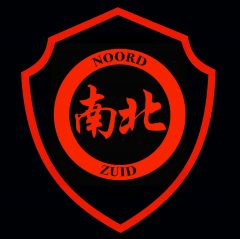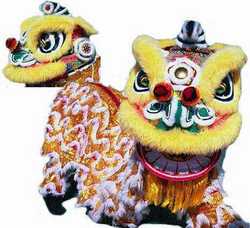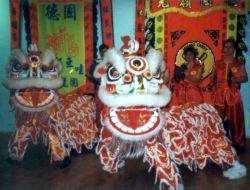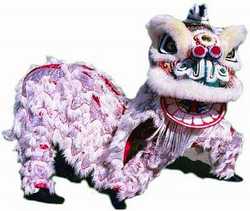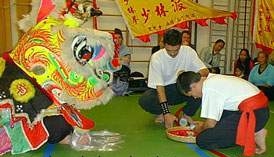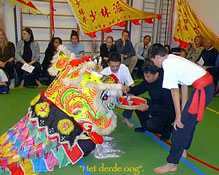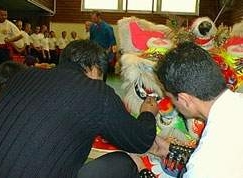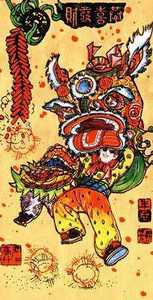 Introduction
Introduction
The first tiger was brought to China as a tribute during the reign of the Emperor Shun (126-145) of the Han dynasty. But China had no zoos, and very few people had actually seen a lion.
The lion, with his strength, represents a powerful figure that protects the villagers from evil spirits and the devil. In traditional Chinese culture the lions are seen as peaceful creatures and widely considered as divine animals of nobility and dignity. Through out Chinese history the lion has been used to symbolic strength, courage and wisdom.
Lions are also thought to bring strength, balance and health to the village and its people. Buddhists and many others use it to represent courage, energy and wisdom. In this context the Chinese consider the lion to be a peaceful creature, unlike the fierce tiger which is native to China. Lion dance performance have been a common sight in Chinese culture whether it’s Chinese New Year, grand openings, or special functions.
Since the 3rd century AD pair of guardian lion statues, can often been seen in front of official buildings and temple’s to protect these premises. The pair is often made up of a male lion on the right and a female lion on the left. The right paw of the male lion rests on an ornamental ball and under the left paw of the female lion is a cup. The number of curls on the head of these lions depends on the rank of the officials whose premises they are guarding.
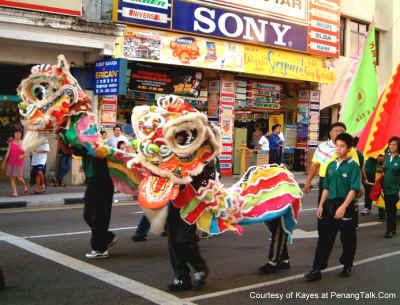
The lion dance (Shi Zi) is not originally from China although it is know as a part of Chinese tradition. As lions are not native to China, which explains why the “lion” in the dance acquired characteristics of the Chinese dragon and phoenix. Lion dancing is believed to have started during the Tang dynasty (618-906 AD). The lion dance was introduced in not only China, but also in Korea and Taiwan, where lions are not native either. The dances are not exactly the same in these countries, but the symbolism is quite similar.
In the Tang dynasty, the lion dance was performed in a group of five lions of different colors. Each lion was followed by twelve men dressed in colorful costumes, with a red band round the forehead and a red colored brush in hand. These people were called ‘Lion-men’ and they danced in tempo to the musical pieces called ‘Tai-pin’ melody.
This ‘Tai-pin’ melody was composed as early as (951-960 A.D.) during the Zhou dynasty. It was recorded that the lion dance was accompanied by 140 people singing the melody and 64 dancers. Lion dance at the time was a grand occasion and it was different from the lion dance now.
LEGENDS
There are 2 main legends as to how lion dance arrived in China. These legends tend to focus on the southern Foshan style.
First version: Village
A long time ago a strange creature appeared in China and it terrorized a village in China; it horrified and ate men and animals. The fast and fierce creature was called “nian”, which sounds like the Chinese word for “year”. After awhile, the villagers were fed up with the beast thus they came together with an idea. The idea they have was to make a beast from paper mache and some noise making musical instrument like gongs, drums and cymbals to scare away the beast. The idea they had worked thus the villagers celebrated with firecrackers. Thus the belief of lion dancing is to bring good luck and prosperity while driving away the evil.
Others say that there was a Kung-Fu expert who learnt of beast and went into the forested mountain to fight with it. He fought with the lion on three occasions but was unable to capture it. So he called up some of the villagers and trained them in martial arts with the intention to kill the lion. A few months later, they went up to the mountain again and finally they killed the lion. The villagers, in order to celebrate this occasion, followed the steps of those who fought with the lion and thus the ‘lion dance’ was composed.
Another version says that the villagers asked the fox and the tiger for help; but neither of them could fight the “nian” effectively and in despair the people asked the lion for help. The lion shook his mane, rushed towards the creature and wounded it. The nian hurried away with the tail between its legs. But it announced to return to take its revenge. A year later, the nian returned as promised. This time, the lion could not help the people. He was too busy guarding the emperor’s gate. So the villagers decided to do the job themselves. Out of bamboo and cloth they produced an image of the lion. Two men crawled inside it and approached the nian. The “lion” pranced and roared and the monster fled away again. This is the reason why on the eve of the Chinese New Year, lions always dance. They are frightening evil away for yet another year. From the fourth day to the fifteenth of the New Year, lion dance groups would tour from village to village in traditional China.
Another account of this same story tells that the beast itself was a tiger and that the villagers didn’t now how to stop the lion’s attacks so they went to ask for the help of a Buddhist monk. It is said that the monk tamed the lion which in turn became the protector of the people. This monk is often represented by big headed Buddha (Datou Fu), seen usually in most southern lion dances.
Second version: Emporer
Another legend of the introduction of lion dance in China is closely related to an emperor of China. The shortest legend says that an ancient emperor was given a pet lion from travelers from Africa, and after it died the emperor’s court did its best to create a creature like that lion to perform for the emperor.
Another common legend tell us that an emperor had a dream one night while travelling to the south. In that dream in which a mystical creature, from whose middle of the head a horn was protruding, saved his life. In the dream he became separated from his army and lost, with no food or drink he began to panic. The creature protected him and guided him back to the palace. The creature looked at him and then with sparkling eyes disappeared as surprisingly as it had emerged. When the emperor woke up the next morning he decided that from that moment onwards that creature was to be considered as king of the animals. Immediately he gathered his servants, artists and craftsmen around him and began to search for a possible meaning of his dream. His subordinates later concluded that this creature could have been a lion, who wanted to let the emperor know that he was of the same rank as the emperor. From that time onwards the emperor called that animal “Ruishi”. Since the strange animal saved the emperor in his dream, the lion quickly became a symbol of good luck throughout China.
Third Version: Mythical account
It tells the story of lion originated in heaven. The story goes that the this mythical character was very mischievous and a practical joker which created a great deal of trouble. On one occasion he decide to play a practical joke on the Jade Emperor. He was furious because of all the trouble caused by the lion and this was the last draw. He killed the lion by cutting the lions head off separating it from its body. It is said he than threw both the head and the body of lion down to the earth to rot. However not long after this incident, Guan Yin felt sorry for the lion and decided to help him. Using a long red ribbon she tied the lions head back on and brought him back to life. This red ribbon is still seen today is said to have the ability to scare off the evil spirits. Guan Yin also gave the lion a horn to fight with and a mirror to frighten away the evil spirits.
Styles
There are two major different styles of lions in China: Southern Style and Northern Style. They have great differences in that of their appearance and the art of demonstration. Drumming and dancing is different too.
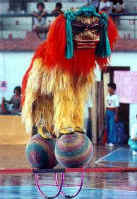
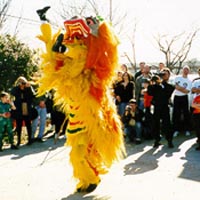 The Northern Lion tends to be more dancing and acrobatic while the Southern Lion is more martial and powerful. The southern lion makes dramatic head thrusts to the sound of drums and gongs; the northern lion makes great use of its prancing legs in its dance. Today, however, the most popular lion dancing is Southern Lion in a Northern Style. Southern lion/northern dancing combines some of the best of both categories of lion dancing. Southern lions now commonly perform some of the highly difficult techniques that once were done mainly by their northern brothers.
The Northern Lion tends to be more dancing and acrobatic while the Southern Lion is more martial and powerful. The southern lion makes dramatic head thrusts to the sound of drums and gongs; the northern lion makes great use of its prancing legs in its dance. Today, however, the most popular lion dancing is Southern Lion in a Northern Style. Southern lion/northern dancing combines some of the best of both categories of lion dancing. Southern lions now commonly perform some of the highly difficult techniques that once were done mainly by their northern brothers.
Northern Style
The lion of northern China is big and has big eyes. It is furry gold and red. The long fur hide of the Yak was traditionally used for the costume of the lion in northern China. The gold colored head of northern lion is smaller than the southern one and has a less moveable mouth and a wide square jaw with a read beard.
There basically two popular styles of northern Lion. The twin lions of Hebei and the single Qing Lion of Anhui province. The Hebei lion dance is usually performed by pair of lions, while Qing lion uses uses a single lion. These two types of lion dance can still be seen in many places. Each lion is performed by two dancers, while a smaller version of this lion also exists, which is controlled by a single performer.
Northern lions look more like real lions than their southern brothers, although they also resemble dogs and the guardian lions found all over China which guard temples and other important Chinese buildings. The movements resemble those of a puppy dog.
Historically, the Northern lion was performed by acrobats for the entertainment of government officials and the emperor. That’s why the style of dancing was very acrobatic and theatrical. The music also sounds more northern, with more influence of beijing opera . Even today, the easiest way to see a northern lion dance is to watch an acrobatics show, where the performance is started or concluded with a lion dance.
The dance of the northern Lion is done in perfect coordination with the rhythmic beating of the accompanying musical instruments. a warrior who holds a ball of ribbon also guides the lion in its display of acrobatic stunt, such as flip, jump or roll.
Due to the early existence of the Northern Lion, there are several speculation behind its origin. One legend claims that during the time of Northern Wei dynasty, a man from an ethnic tribe of Hu brought to central China a ritual dance that uses a wooden head mask portraying a mythical beast. Soon this dance was presented to the emperor, which to the delight of the emperor proclaimed this dance “The Northern Wei Auspicious Lion”. During the time of the Northern and Southern Song , the lion was known simply as the Northern Lion.
Southern Style
In the south, the lion dance costumes are much more colorful. The body is made of different colored fabric and the head consists of fabric stretched over a wire frame. In the south, where the climate is a lot warmer than in the north, the costume does not cover the performers completely, it merely drapes over their bodies. These lions are much more fierce looking it has a fierce face and big eyes with a reversed curve mouth and a pointed horn on its head. The Southern lion itself is divided into two styles. One originating from Fujian province and the other from Guandong province. The Guandong province style itself is again divided into two styles: Heshan Lion and Foshan Lion. There is also a hybrid Southern Lion known as the Fu He Lion. It has the short tail of a Heshan Lion but the curved mouth of the Foshan Lion.
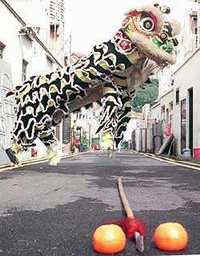
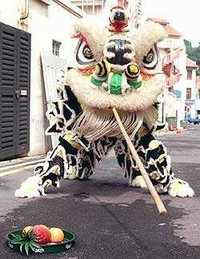 ‘Heshan lion’ style with a narrower head than the Foshan lion and a mouth that looks like a duck bill. Heshan lion has a shorter length body than the Fushan lion. The Heshan Lion has a straight mouth, a curved horn, and a short tailThis style is popular in Malaysia and Singapore and competition teams. Heshan lion is kind of a blend of northern lion and popular Foshan lion. Because of its popularity in Malaysia it is sometimes referred to as the Malaysian lion.
‘Heshan lion’ style with a narrower head than the Foshan lion and a mouth that looks like a duck bill. Heshan lion has a shorter length body than the Fushan lion. The Heshan Lion has a straight mouth, a curved horn, and a short tailThis style is popular in Malaysia and Singapore and competition teams. Heshan lion is kind of a blend of northern lion and popular Foshan lion. Because of its popularity in Malaysia it is sometimes referred to as the Malaysian lion.
This lion is a lot lighter than the Foshan lion which makes it ideal for beginners or younger performers because it is easier to carry and to use. Apart from it being very light it is also ideal for a beginner because its footwork and stances are very easy to learn and it doesn’t require one to be trained in martial arts.
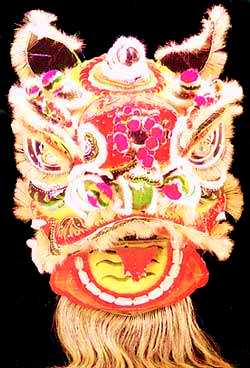 The traditional style lion is the ‘Foshan lion’. The Foshan lion has a curved mouth, a pointed horn, and a long tail. It was developed in the town of ‘Ling Nan’ or ‘Lin-Han’ of Zhejiang province, although the name Foshan a different area implies. In this town there lived a martial art master with the name of Yang Xian Qiang. He lived in the western part of town, known as Huang Sha Yang. He added elements of the Martial Arts to the excisting lion dance. Because he was a soldier as well, he was versed in drumming techniques used in the army to communicate over long distances. He incorporated the drum (gu) in the lion dances as well and in doing so created the basis of the use of the cymbals (cha) and the gong (luo). The style he created was named after the part of the town Yang Xian Qiang came from: Huang Sha Shi Zi (Huang Sha Lion Dance). The sound of the drums is also an imitation of the roars of a lion.
The traditional style lion is the ‘Foshan lion’. The Foshan lion has a curved mouth, a pointed horn, and a long tail. It was developed in the town of ‘Ling Nan’ or ‘Lin-Han’ of Zhejiang province, although the name Foshan a different area implies. In this town there lived a martial art master with the name of Yang Xian Qiang. He lived in the western part of town, known as Huang Sha Yang. He added elements of the Martial Arts to the excisting lion dance. Because he was a soldier as well, he was versed in drumming techniques used in the army to communicate over long distances. He incorporated the drum (gu) in the lion dances as well and in doing so created the basis of the use of the cymbals (cha) and the gong (luo). The style he created was named after the part of the town Yang Xian Qiang came from: Huang Sha Shi Zi (Huang Sha Lion Dance). The sound of the drums is also an imitation of the roars of a lion.
The Foshan style is popular in Hong Kong and most other overseas Chinese communities. The name of the lion changed after the end of the revolution. People in China created a new lion in remembrance of the victory, it was given the name ‘Sheng Li’ meaning Lion of victory.
Foshan lion is usually performed by the gung fu practitioners. It is routines and movements are heavily influenced by Chinese Martial arts. This lion dance requires strength, stamina, co-ordination, fast foot work and deep stances as well as many other aspects which are part of normal martial art training.
The head of the lion is quite heavy which requires strong arms and shoulders. It also has a very moveable mouth, eyes and ears. The length of the lions beard represents the character/age of the lion and how long the school it represents has been in existence. A younger lion when dancing with an older/wiser lion should always show respect.
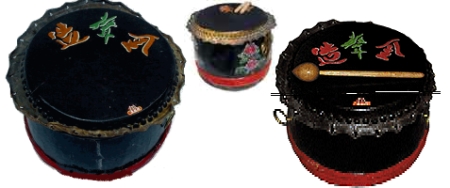 For a proper lion dance, the movements must match the music played by a minimum of three pieces: a drum, a gong and a cymbal. Either the person performing in the lion head or the drummer initiates the movement and signals the other, so that the movement and music is synchronized. The drummer must be very skilled and must know which drum beat goes with each part of the lions movements or emotions. The cymbals and the gong follows the beat of the drum. In other words or simply the whole lion dance team must work together.
For a proper lion dance, the movements must match the music played by a minimum of three pieces: a drum, a gong and a cymbal. Either the person performing in the lion head or the drummer initiates the movement and signals the other, so that the movement and music is synchronized. The drummer must be very skilled and must know which drum beat goes with each part of the lions movements or emotions. The cymbals and the gong follows the beat of the drum. In other words or simply the whole lion dance team must work together.
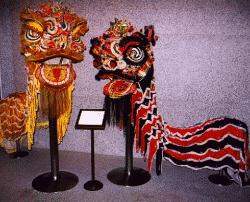
The southern style lion dance has become an extension of the Chinese Martial spirit. Historically, the dance was used to supplement martial arts training, pass along secret messages between revolutionaries, raise funds, advertise the skills of the school’s master. That’s why powerful stances, waist and arm strength is so important to southern lion dancing. The lion dances usually reflect the martial arts style of the school. For example, in Hung Jia (Hung Gar), the students practice very deep stances, with the power coming from the twisting and rotation of the waist. In Cai Li Fo (Choy Lay Fut), movements are quicker. No matter what style, the lion movements are feline in nature.
The legendary Huang Fei Hong (Wong Fei Hung) was extremely well know for his excellent lion dance and was sometimes referred to as the “King Of Lions”.
Some of the martial artists who did the lion dance were fugitives from government oppression, and they ended up hiding with Chinese opera performers on boats that traveled from town to town. The painted faces of lions began to take on some of the characteristics of the painted faces of opera performers. Even the balls on modern southern lions trace their origins to opera performers who commonly adorned their headdresses with the same kinds of silk balls.
The lion dance also plays an important role in the consecration of temples and other buildings, at bus
iness openings, planting and harvest times, official celebrations, and religious rites.
Lion heads are constructed of papier mache applied over a frame of wicker and rattan. Some of the modern heads use aluminum and plastic in their construction, to reduce the weight of the head. Within the head are bamboo levers and pull-strings that allow the lead dancer who carries the lion head to manipulate the lion’s mouth, eyes, and ears for expression of moods. The lion dance involves many different routines where the lion expresses different emotions. Some of these are namely, sleepy lion, happy lion, angry lion, suspicious lion, joyful lion, drunk lion etc.
A long sheet of bright, multi-colored cloth forms the body and tail of the lion.
When the lion bares the five colors yellow, black, green, red and white, it is said to have control over the five cardinal directions; North, South, East, West and Heaven. The costume is composed of many symbolic shapes. The bird shaped horn represents the phoenix. The ears and tail are of the unicorn. The protruding forehead, adorned with a mirror which deflects evil forces, and the long beard are characteristic of Asian dragons.
Southern lions also carry a religious significance. A new lion usually undergoes an eye-dotting ritual which gives the lion its “spirit”, because it must be brought to life and filled with a spirit through a religious ceremony. This is most of the times by a Taoist ceremony but it can be performed by any person with a high social status. The areas to be dotted with red pigment called “Zhu Sha” are the eye, ears ,nose, horn, feet, and the body; usually only the eyes are done in a public ceremony. The light in it’s eyes resembles that the lion’s eyes have been opened with a spirit and the shield reflects the good light from the heavens, although other explanations can be given for the mirror.
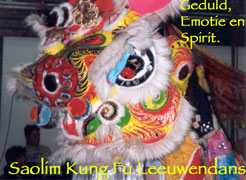
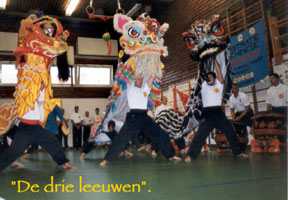 The red ribbon on the horn is also a religious symbol of honor, wisdom and courage. The red ribbon is also related the the creation-legend with Guan Yin. Each new ribbon symbolizes that the lion is more knowledgeable of what is good and right. Therefore, an older more experienced lion will be bear more red ribbons.
The red ribbon on the horn is also a religious symbol of honor, wisdom and courage. The red ribbon is also related the the creation-legend with Guan Yin. Each new ribbon symbolizes that the lion is more knowledgeable of what is good and right. Therefore, an older more experienced lion will be bear more red ribbons.
The heads are painted different colors used to signify different characters. Although nowadays there are many different colored southern lions, traditionally are 3 different types.
Each one of these lions represents one of three famous Chinese Generals, as they appear in the classic novel “Three Kingdoms”. Here are the colors of the heads (and bodies) and which characters they signify:
 The multi (7) color faced lion represents General Liu Bei; sometimes this lion is also reffered to as the white or yellow lion. This lion which has a long white beard and brow with a body having five colors. This lion is called ‘Rui Shi’ or auspicious lion. He is the oldest and the wisest of all of the three. This yellow faced lion shows general Liu Bei’s intelligence, bravery and kindness. It symbolizes wisdom, intellect and integrity.
The multi (7) color faced lion represents General Liu Bei; sometimes this lion is also reffered to as the white or yellow lion. This lion which has a long white beard and brow with a body having five colors. This lion is called ‘Rui Shi’ or auspicious lion. He is the oldest and the wisest of all of the three. This yellow faced lion shows general Liu Bei’s intelligence, bravery and kindness. It symbolizes wisdom, intellect and integrity.
 The red faced lion with black beard and brow, green nose, red and black colored body is called ‘Xing Shi’ or awakened lion. This lion represents the famous Chinese general Lord Guan, it shows General Guan bravery, righteousness and loyalty which he is known for. The red faced lion also represents happiness, good luck and prosperity.
The red faced lion with black beard and brow, green nose, red and black colored body is called ‘Xing Shi’ or awakened lion. This lion represents the famous Chinese general Lord Guan, it shows General Guan bravery, righteousness and loyalty which he is known for. The red faced lion also represents happiness, good luck and prosperity.
 The youngest out of all three is the General Zhang Fei who is represented by the black lion which looks a lot more fierce than the other two lions. The black lion has a short black beard and represents General Chang Fei’s bravery and strength. It is movements are quick, sharp and energetic. It symbolizes youth and courage. This lion is used by newly established schools which hasn’t been around for long.
The youngest out of all three is the General Zhang Fei who is represented by the black lion which looks a lot more fierce than the other two lions. The black lion has a short black beard and represents General Chang Fei’s bravery and strength. It is movements are quick, sharp and energetic. It symbolizes youth and courage. This lion is used by newly established schools which hasn’t been around for long.
Another two traditional types exist: the yellow face with silvery white beard and brow is called “Huang Zhong Shi” which symbolizes righteousness, and the green face with iron-like horn and teeth with white beard and brow is called “Zhao Yun Shi” which symbolizes heroism.
Two dancers (Buddha’s) perform as the lion: one dancer carries the head, the other becomes the lion’s tail. Both lion dancers must work especially on stance training to improve their strength. The big headed Buddha is usually quiet acrobatic and can be male or female who acts as the caretaker or tamer of the lion. The person who performs the role of big headed Buddha wears a big pink mask with a big smile, which is why some people call him the laughing Buddha. The big headed Buddha usually wears a traditional costume and carries a fan or a ball which he uses to play with and tease the lion.
The heavy lion head requires a dancer with strong shoulders and arms. The lion head is characterized by quick, lively movements, and is often raised high above the dancer. The movement of the mouth, eyes and ears helps to establish the lion’s basic attitude. The footwork used by the lead dancer incorporates all of the various Martial Art stances and kicks.
The dancer performing in the lion tail is equally important, as lions have four legs. He must duplicate the lead dancer’s stances while remaining in an awkward, stooped posture with restricted vision. The dancer in the lion tail must have a strong back and legs in order to perform bent over the entire time. This dancer may also be called upon to raise the lead dancer high in the air, performing as a lion on “hind legs”.
The dancers should display through the lion the general emotions of excitement, anger, sadness, happiness, fear, suspicion, greed and worry. There are some basic reactions for the lion, a few examples are: when seeing green (vegetables) it should be happy: upon seeing the color red, it should be surprised; when crossing over a bridge, it should try to see his own reflection in the water; when there is wood, it should bite it and when there is a post, it should try to climb it.
Certain customs and traditions are followed by the schools of southern lion dance. These schools have different practices or beliefs, but they do follow general rules especially when different lion dance groups converge. For example, when two lion dance groups meet, the dancers should not stand on one leg when holding the lion head for it is a sign of disrespect. Another rule is that a lion should not try to bite or sniff the tail of the other lion as these actions can lead to fights between the two groups. There are certain rules a lion dance team must follow in order to avoid being insultive or bringing bad luck. Some of these rules or correct etiquette are: A new lion should not be used in a lion dance until it goes through the eye opening/dotting ceremony, a younger lion should always show respect to an older lion and it’s head should not be held higher than the older. When performing during events such as new year and other festivities with other lion dance teams lion heads should be at the same height. Keeping the head higher than the other lions is insulting and offensive and may result in a challenge. The beard of the lion should not touch the ground, in fact the head should never touch the ground during the dance. If the lion dance takes place inside a building such as a restaurant or a shop, lion should bow 3 times (to the owner) before entering and while inside if there is an altar it is also polite to bow again three times. When leaving/exiting a building, lion should exit tail first then the head. During choy cheng stage of the performance the lion should eat the green first before taking the red envelope. Prior to a performance, the lion should lick the drum and the door before leaving the school as well as when it comes back.
Traditional lion dance performances also include the lighting of firecrackers to scare away the evil sprits. Although this is not very common in many western countries due to the legal issues, it is still done in many parts of south east Asia. Another feature in the southern lion is the laughing Buddha or big headed Buddha (Datou Fo) who guides the lion and brings out laughter from the spectators with his funny antics. He handles a a fan or a giant ball.
The lion dance team consists of at least 5 people or 6 people if the team has the big headed Buddha. The two members of the team perform the actual lion dance. The other three members of the team plays the musical instruments. One plays the drum, one for the gong and one for the cymbal. Although many teams don’t use the big headed Buddha, the big headed Buddha is an integral part of the lion dance.
The lion dance performance generally depicts a lion stalking for food (vegetables) along with a red packet containing money which express the gratitude for the blessing.
There are two basic types of lion dances – freestyle and the set method. In the freestyle form is used when dancers would parade through a village, visiting homes and stores during the New Year Celebration. The visit, called the “Pai” brought good luck to residents and businesspeople. Those expecting a visit from the lions would hang a head of lettuce or a similar green above their door. Inside the chan would be, inside the green having a red envelope with money for the lion dance tea. To get the gift lion dancers have to overcome physical obstacles and solve puzzles. These included athletic feats such as jumping between high poles or climbing the wall of a building.
The other type is a set type. The lion dance performance usually follows 3 stages during which the lion goes through and expresses many different emotions and displays different routines. The basic stages or parts of a lion dance performance are the opening, eating the green and closing. The dance involves a cycle of carefully choreographed sequences which include an opening with three bows, sleeping/dreaming, awakening/grooming and exiting the cave, playing, searching for food/eating and returning to sleep.
The lion dance begins with the opening stage where the lion bows 3 times which is a sign of respect and represents good luck greeting as well as showing the good nature of the lion. Traditional the lion is also required to bow to all religious and important figures or statues.
The vegetable is fed to the lion. This tradition dates back to Qing Dynasty. During this period, the people have suffered long under corrupt officials. In order to unify the revolutionaries they thought of a way to symbolize their hatred against this regime without jeopardizing the lives of the common people. In villages, they used lettuce or green = qing in Chinese, which is some say actually a pun of the Qing regime, which almost pronounced in the same way. Thus during lion dance performances a lion sees the Qing and goes for it by chewing and spitting it out, thus symbolizing their hatred against the present Qing government. This propaganda soon spread to many villages and eventually became a tradition that is practiced and preserved long after the fall of Qing Dynasty. Many martial artist who were also Ming patriots who wanted to overthrow the Ch’ing used lion dance to pass secret messages inside the vegetables.
But generally the the act of eating and dispersing of the green (choy cheng) is seen as a symbol of wealth and good fortune to all those present. These symbols combine to cure sickness, bless marriages and guard against misfortune. For parties, instead of the lion performing the choy cheng, usually a scroll with calligraphy with wishes of good luck, healt, money and old age. The scroll is to be kept by the hosts.
Payment to the performing group is usually made through the choy cheng. Usually the fee is in the form of a hong bao (lucky red envelope with the payment enclosed) which is tied to the vegetable matter. The greens are placed in an area for the lion to “eat.”
Before reaching the vegetables, the lion must overcome certain obstacles or tests. These tests differ from school to school;in the Heshan style these obstacles led to competions in stake walking.
There are many different types of obstacles placed before the choy cheng which the lion dance performers must pass through in order to get the green. The most commonly used obstacles are stacks of benches and tables etc.There are also variety of special routines/performances which are associated with the eating of the green such as three stars surrounding the moon (sam sing bune yuet) and seven stars surrounding the moon (chat sing bune yuet). All these obstacles and different routines are used to test the skill of the lion and makes the lion dance more exciting to watch.
Sometimes Chinese martial arts weapons representing a snake are laid down on the floor before the lettuce. The choy cheng is usually hung from a doorway or similar places which is high of the ground. Sometimes the choy cheng might be on top of a very high pole or a building which requires very skilful dancers to get to it.
Some other types of etiquette that may be followed include testing the door opening, bowing to certain Buddhas represented by figurines, and bowing to those present having a high status.
The lion will carefully approach the vegetable and even test it to make sure that it is safe and not a firecracker or other dangerous item. It will very carefully approach near the green and blink its eyes to see through the green. Then using its head or the leg the lion will touch the green to make sure it really is food. After testing on the left and right sides, the lion will do a 3-Star routine (stepping to the 3-Star music) to ward off any others that may want to eat his vegetables. The lion walks back and forth, in a zigzag path, in order to confuse evil spirits, which the Chinese believe move in straight lines.
The lion will then pick up the vegetables in his mouth and “chews” it. The person manipulating the head first removes the “hong bao and places it inside his shirt, so as not to drop it, which would mean bad luck. Then he will tear the lettuce apart and throw it out first to the left, then to the right and then to the middle to help spread prosperity in all directions. Sometimes but very rarely a hard coconut or other type of food are used instead of the usual lettuce. The music will then change to “high dance” and the head will be raised and moved as if the lion is happy to have consumed his prize.
Being hit by the choy cheng which the lion spits out is said to bring good luck. Traditionally shortly after the eating the green part of the lion dance the firecrackers will be exploded and the lion dance will continue for a short while longer. The final part of the lion dance is the closing part where the lion bows three times which concludes the lion dance performance. The traditional lion dance always begins and ends with the lion bowing three times.
In writing this text, I used numerous texts which I found on the internet. The pictures used here all come from the internet as well. If you feel I used so much info from your site that you think you should get credits then let me know. If you feel I used pictures from your site that I shouldn’t have been using, let me know and I will remove them promptly.
S.Scholten shmscholten@gmail.com
Lion dance in Penang, Malaysia.
Lion dance in Penang, Malaysia.
